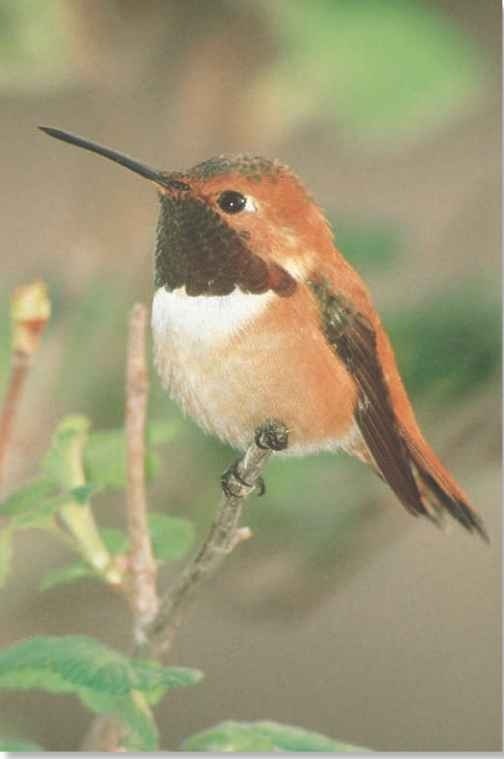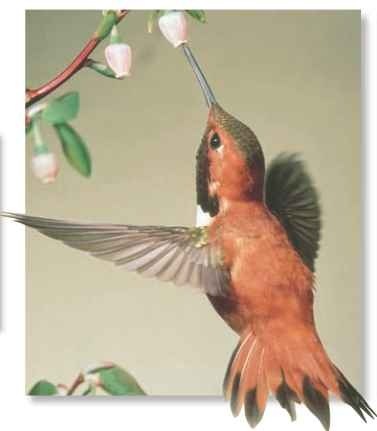ORDER
Apodiformes
FAMILY
Trochilidae
GENUS & SPECIES
KEY FEATURES
• Hovers above, below and beside flowers to reach sugary nectar
• Male is the only hummingbird with a solidly cinnamon-rufous back
• Collects nectar at a rate of 13 licks per second
• Enters a torpid state at night; lowers body temperature and decreases heart rate to conserve energy
WHERE IN THE WORLD?
Nests from south Alaska and south Yukon to east and central British Columbia, south through Montana, Idaho and California; winters in Mexico, south to Guerrero and northern Oaxaca
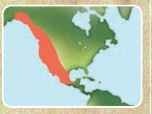
Lifecycle
A rufous hummingbird’s world revolves around flowers: the bird hovers like a helicopter, moving in all directions around the bright blossoms.
Habitat
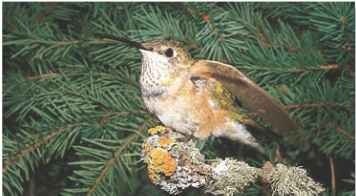
A Saving energy
The hummingbird perches quietly in the forest.
Forests, forest edges, meadows, woodlands and even dense shrubland attract the rufous hummingbird. The bird ventures farther north than any other hummingbird, being found even in southern Alaska. It is widespread south through California during the breeding season, and winters in Mexico, enticed by the sweet nectar of the flowers that bloom in these western habitats. During its fall migration, the bird is often blown off course by fast-moving storms. An adult is usually able to find its way to its original destination, but a juvenile often finds itself farther east. Rufous hummingbirds have been sighted in all of the midwestern and eastern states, including Florida.
Hummingbirds prefer a concentration of 1 part sugar to 5 parts water.
The rufous holds the record for longest distance between banding and recovery for hummingbirds: over 1,700 miles.
Hummingbirds are called beija flor (flower kissers) in Portuguese.
Hummingbirds have the fewest total feathers of all birds and the largest relative heart size of all birds.
Food & feeding
behavior
Hummingbirds are well known for their finesse in flight. The rufous hummingbird moves its wings an average of 28 times per second during its expert hovering maneuvers. These quick movements require a lot of energy, and the bird’s heart rate and temperature both increase. Unlike mammals, the hummingbird’s temperature fluctuates, from 102— 108°F. The bird often cools off by panting, but also spends almost 80% of its time perched, digesting its food to be used as energy for its next foraging trip. To conserve energy during the night, the bird often enters a state of torpor. Its temperature often matches the environment, dropping to around 70°F or even lower Its heart rate decreases as well, down to 40 beats per minute from the usual 500- 1,300 beats.
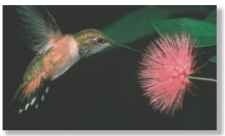
The rufous hummingbird frequents funnel-shaped flowers — from manzanitas to madronas, columbines to currants. A hummingbird learns after one taste whether the plant is worth returning to: if the sugar concentration is right, the bird will revisit time and time again. Nearly all of the sugar consumed by a hummingbird is turned into energy: it takes less than an hour for the hummingbird to convert sugar to energy needed for flight.
A rufous hummingbird’s favorite flowers are those that bloom abundantly without any surrounding twigs or leaves that would hinder the hummingbird’s hovering movements. The bird is able to hover above, below or beside the flower while inserting its bill and extending its tongue deep into the petals. It quickly collects the nectar; at up to 13 licks per second. The rufous hummingbird also pollinates the flowers it visits, aiding in their reproduction. While eating, pollen sticks to the bird’s head, bill and throat; when the hummingbird moves to the next flower; it transfers the pollen.
The rufous hummingbird also eats protein-rich insects. It often darts into swarms of midges, gnats or flies. These tiny treats also adhere to the hummingbird’s sticky tongue while drinking nectar. This combination of nectar and insects is also regurgitated to the newly hatched young.
quick meals
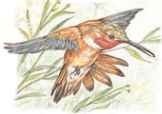
Out…
A male darts out from its perch to seize a midge in midair. Its bill snaps shut on the tiny insect.
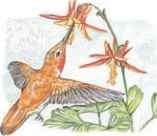
Up…
The bird hovers under a columbine and reaches up to insert its bill into the flower’s nectar pot.
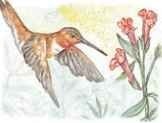
Down…
The bird whirrs its wings in a figure-eight pattern, about to extend its tongue deep into a snapdragon.
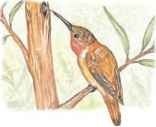
Around
To save energy, the hummingbird sips sap from a hole already made by a red-naped sapsucker.
conservation
The rufous hummingbird is currently not endangered. Though the bird is primarily a forest dweller, it has adapted to this habitat’s gradual disappearance and thrives in parks and gardens throughout its range.
Sweet reward The rufous hummingbird migrates early to take advantage of early blooms on its northwest journey to breeding grounds.
Breeding
Males arrive in the northernmost breeding grounds in May and establish territories before the females arrive. But the territories are for feeding, not for protection of the nest and young. Males perform an aerial display, which concludes with a humming sound made as air passes through the wing when the bird dives. But the males are so possessive of their bright blossoms that they limit contact with the females to copulation only. The female is on her own during incubation and brood rearing. The cup-shaped nest is made of plant down, mosses, bark and lichen, held together with spiders’ silk. The two naked, blind chicks hatch after about 18 days. They open their eyes fully by the 12th day.
At 20 days, the young are ready to leave the nest and become “mini hovercrafts.”
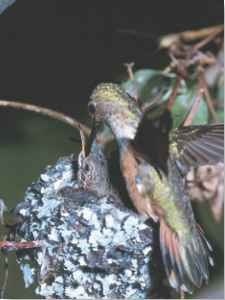
More, please A chick begs for more regurgitated food.
Profile
Rufous Hummingbird
The hummingbird’s feathers glisten like shiny pennies, reflecting light during the bird’s acrobatic forward, backward and upside-down flights.
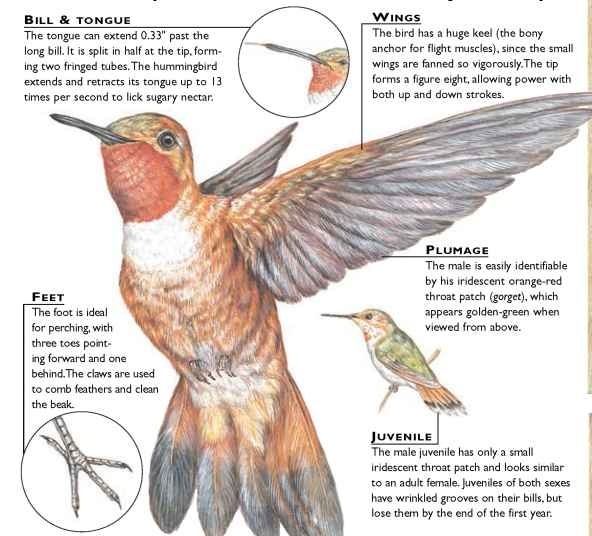
Creature comparisons
Measuring up to 4″ in length, the Anna hummingbird (Calypte anna) is about the same size as the rufous hummingbird. The male Anna hummingbird’s green back is similar to the female rufous hummingbird’s, but the Anna has a crimson helmet. The iridescent helmet glows and darkens under different lighting conditions, much like a soap bubble.The Anna hummingbird is typically found feeding on red gooseberry or bush monkey-flowers throughout California. The rufous hummingbird often passes through the Anna’s year-round home range during its fall migrations to Mexico.
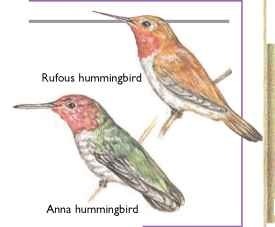
| VITAL STATISTICS | |
| Weight | Average 0.1 oz. |
| Length | 3.3-3.9″ |
| Wingspan | About 4.25″ |
| Sexual Maturity | About 1 year |
| Mating Season | May-June |
| Number of Eggs | 2 |
| Incubation Period | About 15-20 days |
| Fledging Period | 20 days |
| Breeding Interval | Up to 1 year |
| Typical Diet | Nectar and insects |
| Lifespan | Up to 8 years |
RELATED SPECIES
• The rufous hummingbird is joined by 7 other species in the genus Selasphorus, including the ; volcano hummingbird, S. flammula. They are members of the family Trochilidae, which contains more than 330 hummingbird species. The smallest, the bee hummingbird, Mellisuga helenae, measures 2.4″, and the largest, the giant hummingbird, Patagonia gigas, measures 8.5″.
